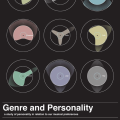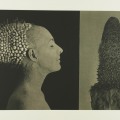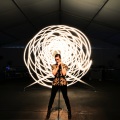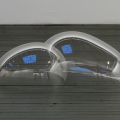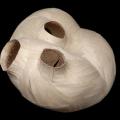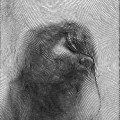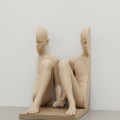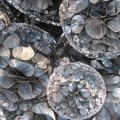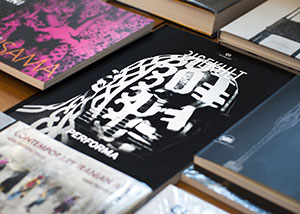A Conversation between Jonathan Callan and Ryan Gander.
JC’s Studio. 12-02-2008
Ryan Gander: When were you last in the studio before today?
Jonathan Callan: Yesterday. I have a routine which is fairly regular, I drop the kids off at school at 9.00 am, come here and work, if it’s my turn to pick them up then I work till 3-30 if it’s not my turn I work until 6.00 pm. I don’t like to stay here too late, I like to try and knock off at a certain time.
RG: My studio is more like an office, more administrative, coming to your studio it’s more hands on, and when you say knocking on and knocking off it makes me think of a punch card work ethic would you say that’s in what you do?
JC: It is yes. I think that’s a big part of the work, sometimes I think I should split the studio up so I’d be able to have an office in part of it, put a computer in there and be able to respond to mail and stuff as I work but it just doesn’t seem destined to be that way, there’s always crap everywhere and I‘ve eventually realised that having the crap everywhere is an important part of the studio setup. It’s important to the development of the work, it’s a big part of how ideas are generated, it’s a very organic thing, where I’ll be working on something, and I’m sure this is not an uncommon situation, something will go wrong or fall on the floor or break and then something else might come from that, it is all very physical. Before I had a studio I worked in notebooks, I still do keep a notebook but the most recent I started 3 years ago and I’m still not through it, whereas before I’d be getting one finished every 3 weeks or so. Sometimes I do go back and read them thinking there might be stuff there that I’ve missed, there might be an idea I could use and there are ideas there but very much in the context of the notebook, they don’t really stand up if you take them out. I’ve never been the kind of artist that has light bulb moments, actually that’s not true I did have one idea that went straight from the notebook to fact.
RG: Which piece was it?
JC: It was the one where an open book has a block carved to fit snugly on top of it, ‘Rational Snow’ I think. It was a thing that’s developed a bit since then, that model BMW behind you is going to have a block on top of it.
RG: The BMW 6 Series?
JC: Yeah, I’m working my way up through a series of maquetes to hopefully do the real thing, it has to be painted up with police insignia.
RG: So you were saying that when you didn’t have a studio the notebook would fill up quicker… is there a physical manifestation of something in the studio that might previously have been a page in the notebook?
JC: Yes… and like in a notebook, there is a lot of stuff that won’t ever work out, there’s a lot of stuff I throw away.
RG: How much do you throw away?
JC: Well the stuff that doesn’t get to see the light of day, it’s got to be around 50%.
RG: Does anyone else get to see it or is it just you?
JC: No no-one else… not really. When something’s gone wrong I’ve recently learnt to put it to one side and leave it hanging around out of sight, rather than trashing it. It’s not always that the thing is wrong, it can occasionally be that it’s slipped over the border to a place that’s outside your normal compass, and when you see it later it can seem a lot more interesting. The work ethic thing is very pronounced though, I do make a lot of stuff, so just from the sheer law of averages a lot of it won’t be that good.
RG: But does anyone else see the things you’re thinking of throwing out? You know the Belgian artist Michel Francois? He says that he shows his daughter the stuff he might be thinking of throwing out and she gets the final say. She’s his editor standing by the studio door, saying that can go, that has to stay… It’s a nice image.
JC: I think it could be useful to have someone doing that. Though actually I have very few people coming to the studio. I have a very solitary practice, there are some visitors but they’re pretty infrequent. You’re the first artist that’s been here for a couple of years.
RG: When I have an idea unless I speak it out loud, verbalise it, it stays in the soft part of my mind, just by saying it to someone; and often I’ll say I’ve made something when I haven’t, it becomes a way of sounding it out, a way of testing it in the world.
_
RG: I’m looking at that brush over there and it reminds me of something you said to me when you were teaching. You said something that I’ve said loads of times since, you were using the analogy of sweeping the floor as an example of how creativity manifests itself, you described a camera pointing at the floor filming ten different people cleaning up and you said that each person would sweep the floor in a different way.
JC: Yes, I may have said that as I think creativity is a biological imperative, we need it to be who we are.
RG: It’s not learnt?
JC: No I think it’s actually one of the things that defines us as being human. You can be in a situation and know that you need to do something and that there are a certain number of ways that you could do that thing and very often you might pick the way that accomplishes the task at hand and then goes beyond it. It seems to me to be something that crops up in every walk of life. It was the thing that I thought was fantastic about Richard Wentworth’s life long piece ‘Making Do And Getting By’. He identified this one part of our behaviour where we almost can’t help but make these connections between things that come as one of the consequences of…
RG: … making do.
JC: Yeah, keeping the door or the window open, and through that, forms of communication are expressed that are established by accident except that I’m not quite sure and I think Richard’s also not quite sure that it is by accident that these other meanings arise, it seems to point to the fact that we are all innately creative.
JC: I have no way of backing this up scientifically but it would seem that in evolutionary terms, it would probably be an incredibly powerful and useful adaptation that you might be able to leap beyond the logical solution to a problem and end up somewhere else.
RG: But isn’t making work just the result of a series of certain decisions? And that those decisions might be strongly influenced by things like… the kind of education you might have had, state school as opposed to private school for example? There must be some learnt behaviour in the production of work?
JC: Sure I agree with that, maybe it’s like… and again I have no reason to suppose I’d be able to back this up scientifically… but the way we learn or acquire language when we’re very young. There might actually be a structural part of the human brain that is switched on just at the age we’re most receptive to learning something as complex and subtle as language, we seem to acquire it in a relatively short time frame and there are some theories that suggest a degree of hardwiring in specific parts of the brain.
JC: It’s difficult… different people have different ideas of what constitutes creativity. Some, maybe most people would only want to recognise it within established or formal frameworks such as art or literature, but I personally think it’s always there… in everything we do.
RG: So… stupid question, but how do you brush the floor?
JC: Er, well I always think about it when I do.
RG: Self aware?
JC: When I was a kid I remember my dad who was a painter and decorator would sweep the floor differently to his brother, my uncle Ron, who was a caretaker, a professional cleaner. My dad tended to push the brush in front of him and my uncle tended to pull it towards him, it always seemed to me to be cooler to do it his way but then anyone is cooler that your dad at a certain age.
RG: What was the other thing that you told me? There were three things that I remembered on the way here… what was it? Oh yeah, once I said that I wanted the things I make to last and go on forever, without me there to support them. And you said ‘I think you’re going to be disappointed’ and I think you said, ‘You’ll always treat your practice better than it will treat you.’
JC: I don’t remember saying that. Though I was thinking earlier on today about how when you’re younger… Well if I take it back to those days when we were both in Manchester, I remember another member of staff, who was in a really bad mood and out of nowhere started criticising the students. He seemed angry that they were doing all the things that young people do, drinking, smoking, generally carrying on as if tomorrow will never come and in exasperation he said ‘They don’t realise they’re all going to die’.
RG: Christ that’s a bit much…
JC: Well he was in a pretty bad mood, and it was the end of the day but it’s stayed with me. As you get older it becomes (the experience of getting older) one of those things that only lifts itself out of the banal and clichéd when you actually begin to go through it yourself, when you begin to really experience time catching up with you. It’s a real yawn listening to this stuff when you’re young as your whole being is set up to be in perfect pitch, you quite naturally believe you’ll live forever, round about the age of 40 your body changes and the little changes begin to nudge you into the realisation that as Martin Amis said, “time’s beginning to get really personal”. And it’s then that you think about work lasting or not lasting in a different way. When you’re young you don’t really give a fuck about the work lasting and I think that’s the way you should always think about it, but you just can’t help your own mortality becoming part of the work. I must admit I do think a lot more about what will happen to the work but I’m not sure that’s a good thing.
RG: So what do you hope for the work?
JC: I don’t know, I don’t know what I think about that. I’ve occasionally had phone calls about work that’s been damaged or broken, one in fact where the work was dropped and completely destroyed and I was strangely comforted by it. In fact the moment I finish something I become extremely bored with it and can’t wait to see it go somewhere else, anywhere else. I remember in the past you describing to me camping in the studio and waking up being surrounded by your work, I am slightly horrified by the prospect of that. That wonderful engagement you sometimes have with a piece as it’s being made where you can speculate about how it might be this or that becomes sealed upon completion. Once I finish a piece of work the imaginative space is closed off, at least for me as the maker. Hopefully for the viewer it’s the opposite. When it’s finished I usually think it’s crap, it’s become a universal response, it’s just an expression of boredom. I think. I hope.
RG: Isn’t that just that when you’ve finished it becomes that thing where you’ve reached the end of the thought tree, you’ve followed the trunk and the branches and you’re out sitting on a twig? You’ve completely out-thought the work by that point. Sometimes at the end I’ll put a red herring on top, just to give myself something to look at, something to decipher.
JC: One of the things you were talking about in one of your lectures was the concept of truth in a work. I am interested in the idea of the lie, either where an artist might fabricate aspects of the biography of the work, the story of its making, or where they might even fabricate aspects of their own careers. I think it happens a lot, it’s a part of my work. Often I’ll physically have to join two or three books together in such a way as to convince the viewer that the book is one that has been found or bought. Theres one that appears to be a tome on Wagner’s Tristram and Isolde when actually it’s secretly amultiple books on how to make perfect gravy, copper tubing and Botswana. The perfect gravy and the rest of it isn’t actually part of the work, it’s totally hidden and only I know it’s there.
RG: Is that manipulating the viewer? Is it ok to do that?
JC: Yes I think that’s all ok. It all reminds me of the truth to materials thing, it would be funny if that came back. It does come up actually when you’re teaching, like with Jack (Strange), he’s very concerned with everything being ‘true’ he seems to hate the idea of faking anything, unless faking were to be the subject of the work. So it seems to be a perennial concern. But for me the relevance of the lie would be where, how can I put it… Ok as students we’ve all been through those slide talks where the visiting artist comes in and lays out their wares along with a story. Often you’ll be interested in the work but will be completely unable to connect what your seeing with what your hearing. The story doesn’t make any sense at all, at least not with what you’re looking at and it’s then really tempting to re-evaluate what your seeing, to see it as less interesting but I don’t think you should ever do that. I think that the miss-match is showing you that the artist has climbed a ladder we can’t see in order to get the work made, the fact that we might think the ladder is rubbish is neither here nor there. When the artist is not there to explain it we’ll be using our own ladders anyway.
It’s one of the joys of being an artist, all sorts of significant moments and turning points are being employed to get the work made, but when the work is complete it can drift away entirely from the makers story, having become a thing unto itself.
RG: So does your work always deviate? I mean it’s visible that you never get singular ideas that are then immediately made. One thing leads to another which then leads to another and so on, but how exactly does one piece lead to he next?
JC: Well… I might be using or making work with faces and of course you’re thinking about the nature of expression and portraiture and the historical use of those things. Almost all of the images and objects I use come with prior meaning, they’re already loaded in some way, the books in particular…
RG: So if you were to do the artists talk like the example you mentioned before, would the back-story be in the work more than in any kind of spoken support that you might offer to help explain what the things are about? Is any of the back-story missing? Is any of it still in you?
JC: I suppose what I’d say is that for me the back-story is irrelevant; a lot of artists would take issue there. Perhaps I should say that the reason my work is so physical and the reason why the studio would probably never become an office is that I’m interested in that, which can be carried by stuff rather than that, which can be carried by stuff and language. Now that’s very hard because then you have the question of how do we know what the stuff is in the first place unless there is a story around it? When I go to the British Museum I can look at the things in there and the objects have been documented and researched, they’ve been placed in all sorts of contexts that help us understand and arrive at the ‘truth’ of those objects. And in every case a short précis of all that information is printed on the white card that sits near the object that we use that as the key. But actually I find myself resenting it. I feel put upon that I have to read it. And more often that not I’ll ignore it, it’s almost become a moral thing for me, I don’t want to engage with its official history. I’m not for a moment claiming that there is the possibility of entering into the world as an innocent person devoid of prior understanding, obviously we go through a process of education… we learn about the world in formal ways and we bring that to bear upon the things we’re trying to understand, perhaps it’s the formality I resent..
RG: Are you talking about the history of something? The stories within that might be universal?
JC: Kind of. You see for me, from the generation that I come from that’s a really dumb position to adopt. I can feel the dismay in folks my age when I bring that out, everything is always about context, to the point where you take the room away and the chairs disappear in puff of smoke, everything is relative… it’s unavoidable but also oppressive. I find myself going to museums and wanting to respond to things outside of the ‘contextual framework’ to look at it without the baggage. And this goes back to the reasons why I started to work with books. Perhaps because of having these critical preoccupations with language and wanting to stress the point over and over again that language is redundant in all sorts of ways, essential though it is for many aspects of life, I’m rambling… ask me another question.
RG: Why do you live in London?
JC: This is where I came to go to college.
RG: When you were at Goldsmiths you built this brick shed no?
JC: Sort of…
RG: With drawings inside?
JC: No, that sounds much more interesting. It was supposed to be a mausoleum, but it ended up being… well, a disaster really.
RG: I remember seeing an image of it but it’s so long ago I’ve probably misremembered it in all sorts of ways, I remember you saying you were a bricklayer before you made that work?
JC: No what happened was… In 1979-80 I was on this fantastic foundation course in Manchester and first began to be aware of conceptual art, by this point the first original wave of conceptual art had already passed its peak – in the early to mid 70’s. And at that time art was moving back into painting and a couple of years after that it moved in the UK at least into object based sculpture that had a pop feel to it but I was out of step and was still really interested in conceptual art. I didn’t have the fashion nounce to move on. A major preoccupation with conceptual art was the modernist concern to try and understand what the activity itself actually was; and I thought by the time I was in my final year at Goldsmiths that I could deal with that in someway and should make the most alien object I could think of for that particular environment – an art school. So at that time in that place it seemed appropriate to propose an object of pure unmitigated craft. Actually I had a discussion with the head, Peter Creswell before the year began telling him I wanted Barrett, the house builders to come in and build a starter home in the studio and I would live in it. But he didn’t like that, so I had to do the mausoleum. So I had to learn how to all of these craft orientated skills, a lot of which I’d tried my hand at in a year out I took in 1982-3.
JC: It took a year to make and everyone new that it would be ‘switched on’ only for three or four days and would then have to be demolished. That equation is the only thing about it that I still think fondly of. As an object it was a complete failure, a terrible aggregation of mindless Victorian detail. It looked like a potting shed imagined by Prince Charles.
RG: But what’s left now, what’s important is the story of it?
JC: I guess you’ve got me there. There was a performative element to it. I’d be in there every day like a parody of manual labour, bricklaying really slowly. I utterly miss-read what I was doing, as a performance it was more interesting. One of the things I’m intrigued about with what you do is and this is almost why I wanted to have the conversation with you rather that anyone else, going back to the idea of the story… it seems to be a crucial to most of the work you make. Conversely with me it seems to be the importance of the object alone.
RG: But the objects you make are vessels for the story.
JC: I don’t know, once I was talking with an artist who teaches at Winchester and he said that the art was not in the object nor was it in the artist. It was in the space between the two. I’ve thought about that a lot since and I think there is a shameful part of me that wants to go completely against it and believe in Animism. A god for each and every thing.
RG: That there is a soul in each object?
JC: I’m not going to say that…
RG: Well I’ve said it for you.
JC: I’ve always been very drawn to people, things, processes, where I can get so close that the detail surrenders every last bit of itself. This was an obsession I had when I was a kid, I’d look at the house we lived in and the detail of how the paint went around the wood, which went around the doorframe seemed a powerful mystery. I thought the whole thing was carved from a single lump. I’d smash up toys within days of getting them not because I was interested in breaking things up per se, though now I do break things down and erode them, and not because I was interested in how things work but I was just fascinated to see the inside and to see if it was fundamentally different to the outside. And I still have to do that now… I still have to find out what’s below the surface of the ink on the photograph. If I scrape it away, will there be something of more significance below. And I am tempted to go the whole way and deliver myself to the idea that there might be tiny gods in everything, That there might be a minute gonk at the centre of that photograph over there who will tell me the secrets of the universe. What I wonder is… to get back to the story theme… what happens to the story when it can no longer be supported?
RG: I don’t know if it’s a question of whether you can have one without the other or which comes first, but if I had to I’d say, for me the story comes first and an off-cut from that story becomes a vessel of some kind which then holds and in some way expresses the story. I’d say we begin from different ends of the same spectrum. When I see one of your sculptures I always imagine what it would be like for a Martian to see it. They’d be oblivious to the fact that it was a book, maybe they’d be interested in the broken paper or the pattern on the surface…
JC: Yes but I ‘m doing it knowing that there is a cultural understanding of what a book is. That knowledge of the object, that understanding always comes first no matter what I do. I’m doing the same thing over and over, trying to say that there are these other ways of knowing the world, like trying to find the gonk in the photograph.
RG: But why is it a small god? Why the insistence on the micro? Why not a large god that’s external? Why not zoom out instead of in?
JC: Do you know the Film ‘The Incredible Shrinking Man’?
RG: No…
JC: Oh you have to see it. It’s one of my favourite films. A B-movie from the 50’s, It’s really simple, as the result of some scientific accident, I can’t remember what exactly, this bloke begins to shrink. And he never stops, that’s the great thing. He’s learning to cope over and over with a world getting bigger, the film ends in an interestingly ambivalent way, he’s caught in a spiders web after having fought with mice and rats and god knows what else, and the spider is getting closer and closer and then the film ends. I wanted it to go on. I wanted to see what would happen when he became smaller than a molecule, smaller than a quark. It implies the infinite through reduction. I love that so much.
RG: We should stop there and when Europa typeset it they should just make the text go smaller and smaller, diminish away.
JC: That would be fantastic.






















